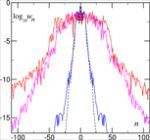EPJ B - Turbulences at a standstill
- Details
- Published on 10 August 2012

Energy flowing from large-scale to small-scale places may be prevented from flowing freely in specific conditions.
For theoretical physicist Dima Shepelyansky from the CNRS-University of Toulouse, France, devising models of chaos and turbulence is his bread and butter. In a recent study published in EPJB, he presents an exception he found in a model of turbulence, indicating that there are energy flows from large to small scale in confined space. Indeed, under a specific energy threshold, there are no energy flows, similar to the way electron currents and energy spreading are stopped in disordered solids.
The author relies on numerical simulations to study a kind of turbulence—known as Kolmogorov turbulence—that describes how energy flows from large to small scale in a confined space. According to this concept, energy is introduced on large scales, e.g. by wind, and it is absorbed on small scales due to energy dissipation. This approach assumes that a small perturbation will make the system evolution chaotic as energy flows from large to small scales.
However, Shepelyansky found that a phenomenon normally observed in disordered metals, called Anderson localisation, which implies that there is no energy flow from one side of the metal to the other, also occurred with the type of turbulences he was focusing on. As a result, energy flow from large scale to small scale does not happen under specific circumstances where the energy level is below a certain threshold level. This result is in keeping with our intuitive experience of a small wind not creating a storm, and that wind needs to reach a certain threshold before a storm can be created. Thus his study successfully links three areas of research based on chaos, disordered solids and turbulence, including wave turbulence, dynamical systems and statistical mechanics.
Kolmogorov turbulence, Anderson localization and KAM integrability. D. Shepelyansky, Eur. Phys. J. B (2012), DOI: 10.1140/epjb/e2012-30193-0




